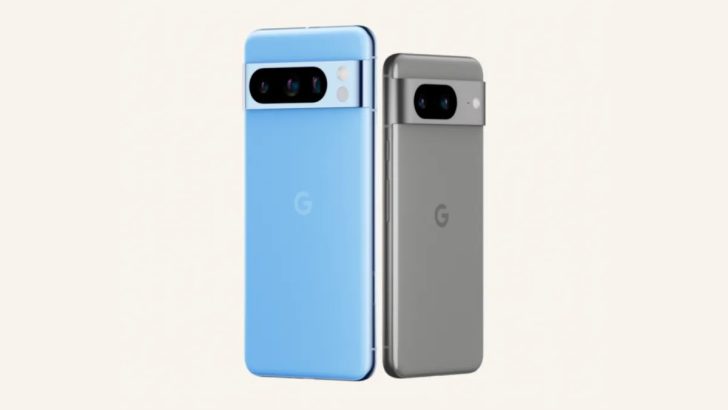Google has unveiled it’s latest Google Pixel 8 series at today’s Made by Google event, following months of leaks and teasing. The series includes the Google Pixel 8 and Pixel 8 Pro, succeeding last year’s Pixel 7 and Pixel 7 Pro.
These devices maintain a similar design to their predecessors, featuring the same rear design with more rounded corners and the familiar camera bar on the back side, reminiscent of the Pixel 7 and Pixel 7 Pro from the previous year.
While the specifications of both devices are similar, there are still noticeable differences that set them apart, aside from the apparent variations in size and camera capabilities. These devices have enhanced Generative AI features, an improved camera system, and Google’s latest Tensor G3 chipset. Check out the detailed specifications of these devices below:
Google Pixel 8 and Pixel 8 Pro Specifications:
Both devices boast flagship-grade specifications. The Pixel 8 Pro features a 6.7-inch LTPO OLED display panel with a resolution of 1344 x 2992 pixels, a 120Hz fast adaptive refresh rate and a peak brightness of up to 2400 nits in bright daylight. Thanks to the LTPO panel, the Pro model can seamlessly switch it’s refresh rate between 1Hz and 120Hz, depending on the displayed content. In contrast, the standard Pixel 8 offers a slightly smaller 6.2-inch OLED display panel with a resolution of 1080 x 2400 pixels, a 120Hz refresh rate and a peak brightness of up to 2000 nits in bright daylight. Unlike it’s Pro counterparts, the standard model lacks an adaptive refresh rate.
Under the hood, both devices are powered by Google’s latest in-house Tensor G3 chipset, representing Google’s most potent chipset yet and delivering a performance upgrade compared to the Tensor G2. The standard model is equipped with 8GB of LPDDR5x RAM and offers storage options of up to 256GB of UFS 3.1 internal storage. Meanwhile, the Pro model has 12GB of LPDDR5X RAM and supports up to 1TB of UFS 3.1 internal storage. These devices come pre-installed with Android 14 and the most exciting aspect is their support for seven years of Android OS and security updates—a notable extension of the device’s usable life.
Regarding optics, the Pixel 8 boasts a dual-camera system, while the 8 Pro model features a triple rear camera system. The Google Pixel 8 includes a 50MP primary sensor with an f/1.68 aperture and a 12MP ultra-wide Autofocus sensor on the back with a 25.8-degree FoV. In contrast, the Pro model’s triple rear camera system is led by a 50MP primary sensor with an f/1.68 aperture, paired with a 48MP ultra-wide sensor with an f/1.95 aperture and 125.5-degree FoV, along with a 48MP telephoto sensor with an f/2.8 aperture and 5x optical zoom. Both models have the same 10.5MP selfie shooter with an f/2.2 aperture, housed in a centred punch-hole cutout at the top of the display.
The standard model features a 4,575 mAh battery with 27W wired fast charging and 18W wireless fast charging, while the Pro model has a slightly larger 5,050 mAh battery with 30W fast wired charging and 23W wireless fast charging. Other specifications common to both devices include an under-display optical fingerprint scanner, USB Type C 3.2, IP68 water and dust resistance, Bluetooth 5.3, Wi-Fi 802.11, GPS, and a full suite of sensors.
Pricing:
With the enhancements in specifications, there comes a corresponding increase in pricing. The standard Google Pixel 8 now starts at $699, representing a $100 increment compared to the Pixel 7, while the Pixel 8 Pro starts at $999, also $100 more than the starting price of the Pixel 7 Pro.
Other Trending News:- News







2 comments